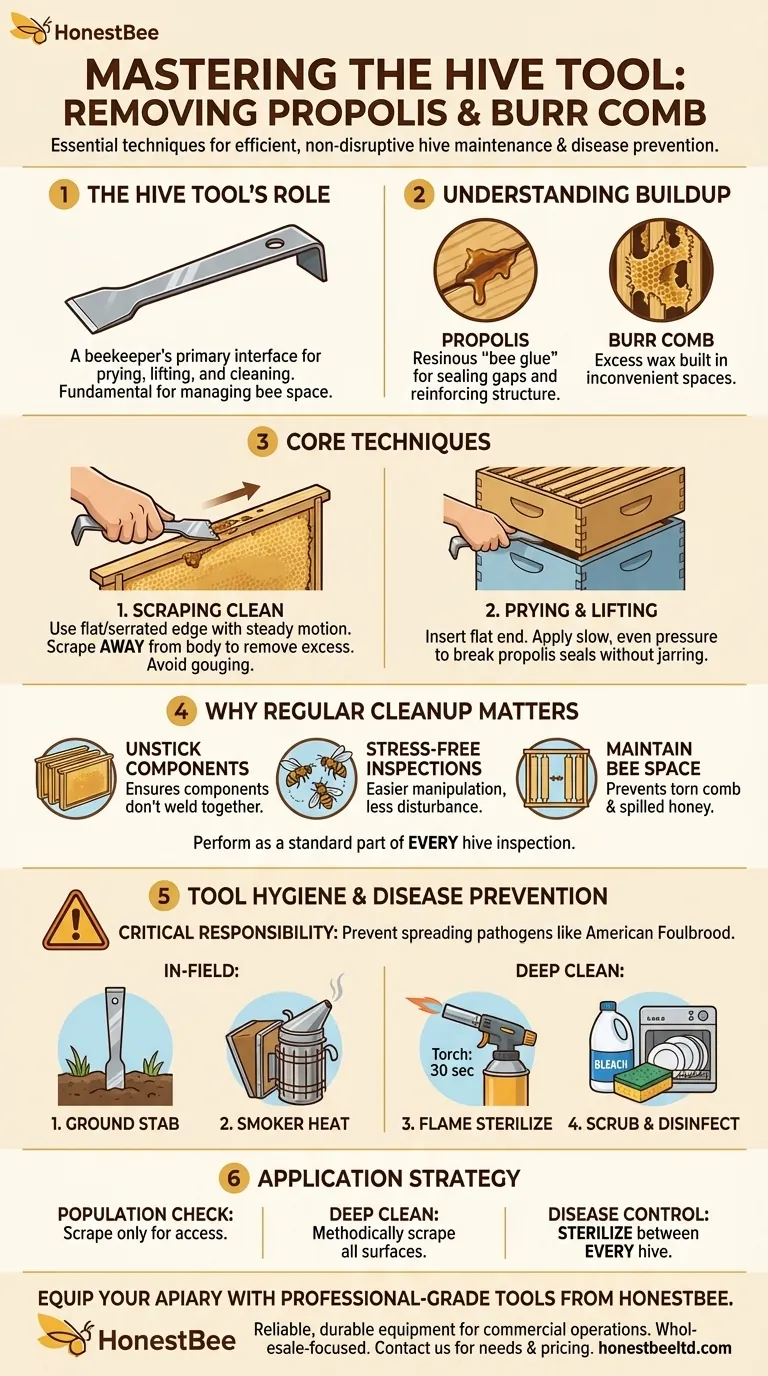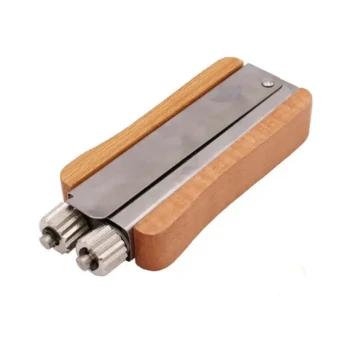To remove propolis and burr comb, you use the flat or serrated edge of the hive tool to gently scrape the unwanted material off frames and hive bodies. This is a fundamental task during any hive inspection, ensuring components don't become permanently glued together and that you can manipulate the frames without damaging the comb or angering the colony.
Your hive tool is more than a simple scraper; it is the primary interface between you and the hive. Mastering its use for prying, lifting, and cleaning is essential for performing efficient, non-disruptive inspections and maintaining a healthy, manageable colony.

The Hive Tool's Role in Hive Maintenance
A hive tool is a beekeeper's most essential piece of equipment. While it excels at cleanup, its primary purpose is to overcome the bees' natural tendency to seal every crack and crevice within their home.
Understanding Propolis and Burr Comb
Propolis is a sticky, resinous "bee glue" that bees create to seal small gaps, reinforce the hive's structure, and even mummify intruders.
Burr comb is excess wax comb built in spaces that don't conform to proper bee space, often connecting frames or hive bodies in inconvenient ways.
Both substances can make hive inspections difficult or impossible if left to accumulate.
The Proper Scraping Technique
To remove buildup, hold the hive tool firmly and use a steady, controlled motion. Scrape away from your body to avoid injury.
The goal is to remove just the excess material that obstructs movement. Be gentle to avoid gouging the wooden frames or unnecessarily disturbing the bees.
Prying and Lifting Frames
Before you can scrape, you often need to separate components. Gently insert the flat end of the hive tool between hive boxes or between a frame and the hive body.
Apply slow, even pressure to pry them apart. This leverage allows you to break the propolis seal without jarring the entire hive.
Best Practices for a Clean Hive
Regularly cleaning propolis and burr comb isn't just about tidiness; it's about maintaining operational control and access for essential health checks.
When to Perform Cleanup
Removing excess propolis and burr comb should be a standard part of every hive inspection. It is far easier to remove small amounts frequently than to deal with a massive buildup later.
Why Removal is Critical
If left unchecked, propolis can weld hive bodies together so strongly that they become impossible to separate. Burr comb can fuse frames, leading to torn honeycomb and spilled honey when you try to lift them.
This cleanup ensures frames are easy to remove, inspections are less stressful for the bees, and you maintain proper bee space within the hive.
Understanding the Trade-offs and Tool Care
A clean hive tool is a safe hive tool. Propolis, wax, and honey can easily transmit diseases from one colony to another, making tool hygiene a critical responsibility.
The Risk of Spreading Disease
Using the same uncleaned tool across multiple hives is a common vector for spreading pathogens like American Foulbrood. Every cleaning action is a step toward protecting your entire apiary.
Simple, In-the-Field Cleaning
For quick cleaning between hives, you can stab the tool into the ground several times.
Alternatively, placing the tool in the hot fire pot of your smoker for a few seconds will burn off wax and propolis while offering some sterilization.
Deep Sterilization Methods
For more thorough cleaning, flame sterilize the tool with a blow torch for at least 30 seconds.
You can also scrub the tool with a stainless-steel scrubber and diluted bleach, followed by a soak in isopropyl alcohol. For a simple and effective option, run the tool through a hot cycle in a dishwasher.
How to Apply This to Your Inspections
Your approach to cleanup may change depending on the goal of a specific inspection.
- If your primary focus is a quick population check: Scrape only what is necessary to pry open the hive and lift a few central frames.
- If your primary focus is a full hive deep clean: Methodically scrape the top bars of every frame, the frame rests, and the inner walls of the hive body.
- If your primary focus is disease prevention: You must thoroughly sterilize your hive tool after inspecting one hive and before moving on to the next, without exception.
Mastering this simple steel bar is a foundational skill that separates a novice from an effective beekeeper.
Summary Table:
| Hive Tool Application | Purpose | Key Technique |
|---|---|---|
| Removing Propolis & Burr Comb | Unstick frames and boxes, maintain bee space | Scrape gently away from your body |
| Prying Apart Hive Components | Break propolis seals for access | Insert flat end and apply slow, even pressure |
| Tool Sterilization | Prevent the spread of disease between hives | Flame sterilize or clean with a scrubber and disinfectant |
Equip your apiary with professional-grade tools from HONESTBEE.
Mastering hive maintenance starts with reliable, durable equipment. HONESTBEE supplies commercial apiaries and beekeeping equipment distributors with the high-quality hive tools and supplies needed for efficient, safe, and healthy hive management. Our wholesale-focused operations ensure you get the best value on essential gear.
Ready to enhance your beekeeping operations? Contact HONESTBEE today to discuss your equipment needs and wholesale pricing.
Visual Guide

Related Products
- HONESTBEE Professional Long Handled Hive Tool with Precision Cutting Blade
- HONESTBEE Premium Italian Style Hive Tool with Hardwood Handle
- HONESTBEE Advanced Ergonomic Stainless Steel Hive Tool for Beekeeping
- Professional Dual-End Stainless Steel Hive Tool for Beekeeping
- HONESTBEE 15-in-1 Beekeeper Multi-Tool with Hammer and Pliers for Beekeeping
People Also Ask
- Why do hive tools have a hole? Unlock the Secret to Efficient Beekeeping
- What are the features of a regular hive tool? The Essential Multi-Tool for Every Beekeeper
- How should beekeepers handle bees when using a hive tool? Master Calm, Deliberate Techniques
- What are the basic tools for beekeeping? Essential Starter Kit for Safe & Successful Hive Management
- What are some common uses of a hive tool? Essential Multi-Purpose Tool for Every Beekeeper



















